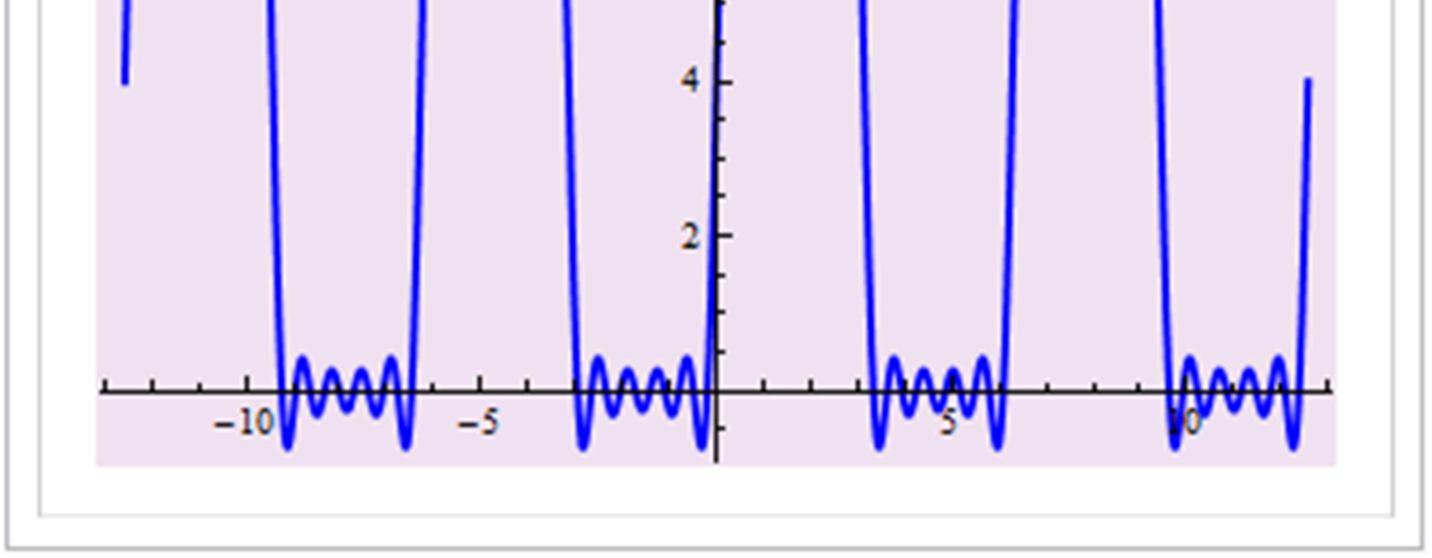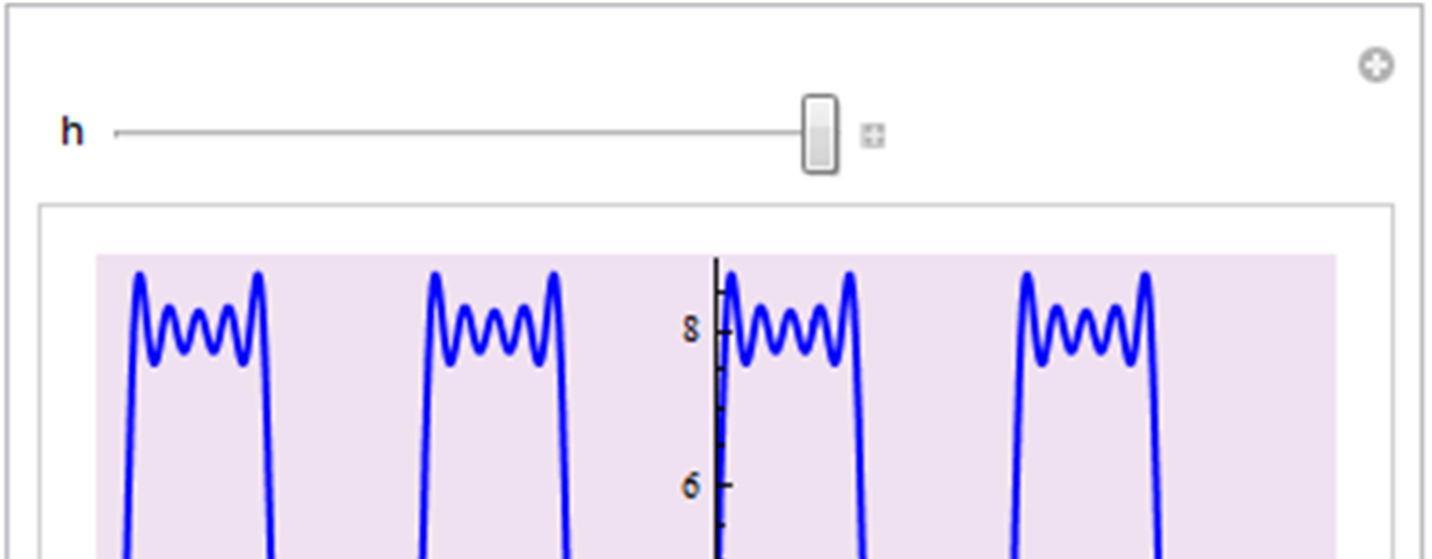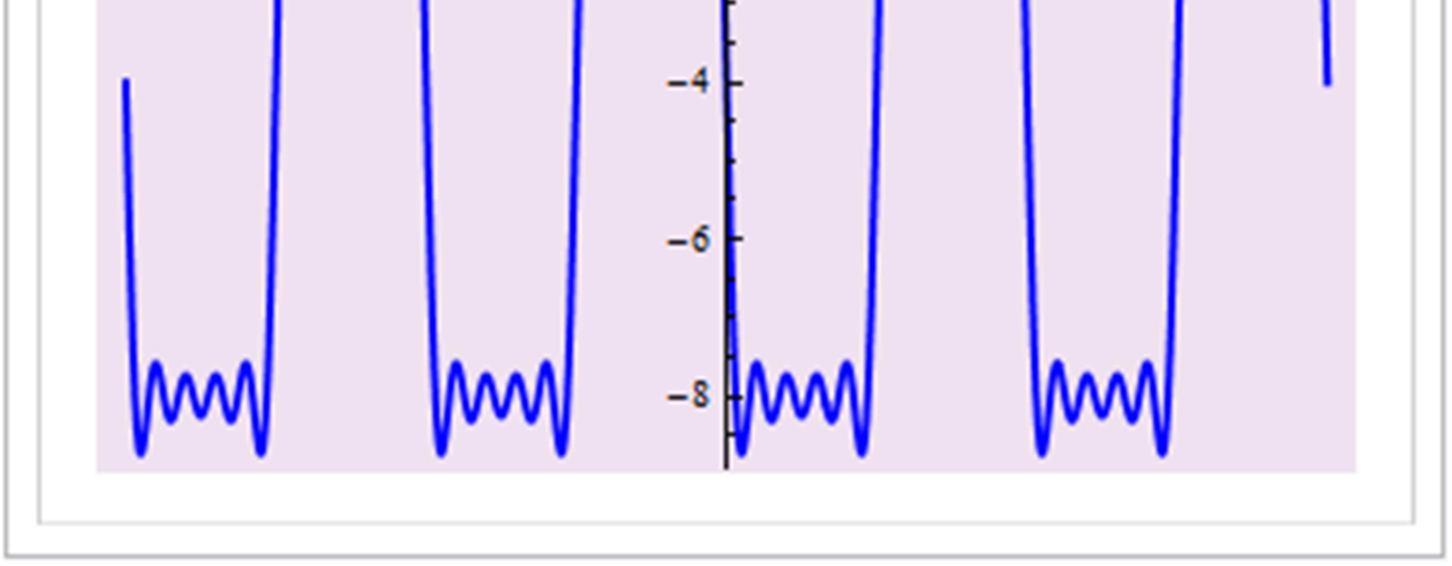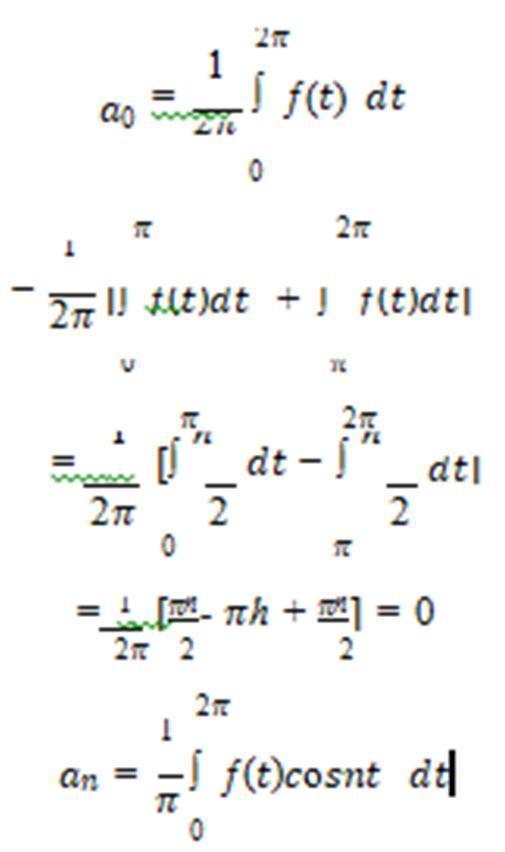https://doi.org/10.22214/ijraset.2023.50376

ISSN: 2321-9653; IC Value: 45.98; SJ Impact Factor: 7.538
Volume 11 Issue IV Apr 2023- Available at www.ijraset.com

https://doi.org/10.22214/ijraset.2023.50376

ISSN: 2321-9653; IC Value: 45.98; SJ Impact Factor: 7.538
Volume 11 Issue IV Apr 2023- Available at www.ijraset.com
 Prof. Suniilkumar Shende2
Prof. Suniilkumar Shende2
Abstract: Fourier series are of great importance in both theoretical and ap plied mathematics. For orthonormal families of complexvalued functions Fourier Series are sums of the φn that can approximate periodic, complexvalued functions with arbitrary precision. This paper will focus on the Fourier Series of the complex exponentials. Of the many possi ble methods of estimating complexvalued functions, Fourier series are especially attractive because uniform convergence of the Fourier series (as more terms are added) is guaranteed for continuous, bounded functions. Furthermore, the Fourier coefficients are designed to minimize the square of the error from the actual function. Finally, complex exponentials are relatively simple to deal with and ubiquitous in physical phenomena. This paper first defines generalized Fourier series, with an emphasis on the se ries with complex exponentials. Then, important properties of Fourier series are described and proved, and their relevance is explained. A complete example is then given, and the paper concludes by briefly mentioning some of the applications of Fourier series and the generalization of Fourier series, Fourier transforms. In the mideighteenth century, physical problems such as the conduction pat terns of heat and the study of vibrations and oscillations led to the study of Fourier series. Of central interest was the problem of how arbitrary realvalued functions could be represented by sums of simpler functions. As we shall see later, a Fourier series is an infinite sum of trigonometric functions that can be used to model realvalued, periodic functions. We shall begin by giving a brief description of the trigonometric polynomials,and especially of their relation to the complex exponentials. The Fourier series, the founding principle behind the field of Fourier analysis, is an infinite expansion of function in terms sine’s and cosines. Fourier transform provides a continuous complex frequency of a function. It is useful in the study of frequency response of a filter, solution PDE, Discrete Fourier transform and FFT in the signals analysis. The advent of Fourier transformation method has greatly extended our ability to implement Fourier methods on digital multimedia visualization system. It covers the mathematical foundations of Digital signal processing (DSP), classical sound, synthesis algorithms and multi-time frequency domain analysis associated musical sound. In this paper, we are analysis of square wave in terms of Fourier component, may occur in electric circuits designed to handle sharply rising pulses and how to convert analog to digital system by using Fourier transform and its applications in electronics and digital multimedia visualization signal process of communication system.
Keywords: Fourier Transform (FT), Fourier Sine and Cosine Transform, Inverse Fourier Transform, Inverse Fast Fourier Transform, Electric Circuit, Frequency, Multimedia Visualization, Digital Signal Process
The Fourier transformation is standard system analysis tool for viewing the spectral content of signal or sequence. The Fourier transform of sequence, commonly referred to as the discrete time Fourier transform or DTFT is not suitable for real-time implementation. The DTFT takes a sequence as input, but produces a continuous function of frequency as output. A close relative to the DTFT is discrete Fourier transform or DFT [1]. The DFT takes a finite length sequenceas input and produces a finite length sequence as output.
When the DFT is implemented as an efficient algorithm it is called the Fast Fourier transformation (FFT). J. W. Cooley and J. W. Tukey are given credit for bringing the FFT to the world in their paper “An algorithm for the machine calculation of complex Fourier Series”, Mathematics Computation, Vol. 19, 1965, pp. 297-301. In retrospect, others had discovered the technique many years before. For instance, the great German mathematician Karl Friedrich Gauss (1777-1855) had used the method more than a century earlier. This early work was largely forgotten because it lacked tool to make it practical: the digital computer [2-10]. Cooley and Tukey are honoured because they discovered the FFT at the right time. Mathematics is everywhere in every phenomena, technology, observation, experiment etc.


ISSN: 2321-9653; IC Value: 45.98; SJ Impact Factor: 7.538
Volume 11 Issue IV Apr 2023- Available at www.ijraset.com
All weneed to do is to understand the logic hidden behind. In this i e ein(−∞, ∞), then the F.T of ℎ( ) is denoted by £(ɸ) and is define by article we are focusing on application of Fourier series in electric circuit and communication system [11-13]. FT isname in the ℎo o of Joseph Fourier (1749-1829), one of the greatest name in the history of mathematics and physics. Mathematically speaking, the Fourier transform is a linear operator that maps a functional space to another function space and decomposes a function into another function of its frequency components. In particular, the fields of electronics, quantum mechanics, and electrodynamics all mark heavy use to Fourier series. Additionally, other methods based on the Fourier series, such that as the FFT (Fast Fourier Transform ƒ o Discrete Fourier Transform [DFT]), are particularly useful for the fields of Digital signal Processing (DSP) and Multi-channel sound analysis [14-22]. In this Study, we sketch the entire figure by using ℎe i 9.0
Let ƒ( ) is a real-valued function of period 2 and it’s a finite sum of harmonically related sinusoids, mathematically the expression for a Fourier series is

Fourier series finding principle behind the field of Fourier analysis is an infinite expansion in terms of sine and cosine or imaginary exponentials. The series is define in its imaginary exponential form is



The Fourier series is only capable of analysing the frequency component of certain, discreet frequency (in -tigers) of agiven function. In order to study the case where the frequency components of the sine and cosine terms are continuous, the concept of Fourier transform must be introduced. If ℎ( ) is piece-wise continuous and absolutely

Here, the £(ɸ) fulfills the role of the ′ in equations (2) and(3); it gives an indicator of “how much” a particular frequency oscillation damping contributes tothe function ƒ( ).
Assume that it has a equidistance, finite set data ℎk = ℎ( k), k = Δ , and it only interested in N equidistance, discreet frequencies in the range ɸ to ɸ It is wish to examine the frequencies ɸ = 2 , for = , , , where Δ 2 2

ISSN: 2321-9653; IC Value: 45.98; SJ Impact Factor: 7.538
Volume 11 Issue IV Apr 2023- Available at www.ijraset.com
Δ be the same Δ be which defines is k ′ . It is provided an approximation to the Fourier transformation in this range by ei sum as follows:


This equation called Discreet Fourier transformation (DFT)of the function ℎ( ). If it is denote £ as



The Fourier transform, £(ɸ) , may then be approximated using the expression

Comparing equation (6) with the Fourier series given equation (2), it is clear that this is a form of Fourier serieswith non-integer frequency component. Currently, the most common and efficient method of numerically calculating the DFT is using a class of algorithms called “Fast Fourier Transforms (FFTs). The first known discovery of the FFT was by Gauss in 1805; however, the first modern “rediscovery” of the FFT was done in 1942 by Danielson and Lanczos. They were able to show one may divide any DFT into a sum of two DFT’s which each correspond to 1 points. The proof of Danielson and Lanczos’s assertion is the following complex number 2
Here, £e denotes the even terms of the sum (the one corresponding to the index 2 ) and £0 denotes the odd terms (the ones corresponding to the index(2 + 1) The most usefulpart of this formula is that it can be used be independently expand using the same algorithm, each time reducing the number of calculations by a factor of 2. In fact, this class of FFT algorithm shrinks the computation time from ( 2) operations to the much more manageable ( o 2 ) operations.

ISSN: 2321-9653; IC Value: 45.98; SJ Impact Factor: 7.538



Volume 11 Issue IV Apr 2023- Available at www.ijraset.com
There are many different FFT algorithms; the one presented here is simply the most common time by 20 or 30 present (so-called base-4FFTs or base-8 FFTs). Most importantly, both classes of FFT algorithm are fast enough toembed into modern digital osciioscopes, multimedia visualization, and electronics equipment. Thus, FFTs have many modern applications, such as Spectrum analyzers, digital signal processors (DSPs), multimedia visualization, digital to analog signal process, and telecommunications systems.

In modern technology, an important instrument to any experimentalist is the spectrum Analyzer. This instrument readsa digital signal (usually a voltage) and provides the operator withthe Fourier coefficients which correspond to each of the sine andcosine terms of the Fourier series expansion of digital signal. Suppose an instrument takes a time-domain signal, such as theamplitude of output voltage of an instrument. Let us call this digitalsignal ( ). Then theDFT of ( ) is
We see that this equation is of the same form of equation (7), which means that the previously described methods of the FFT apply to the function. Thus, any digital oscilloscope that is sufficiently fast and equipped with a FFT algorithm is capable of providing the user with the frequency components of the source signal. Oscilloscopes which are equipped with the ability to FFT their inputs are termed “Digital Spectral Analyzers”. Although they were once a separate piece of equipment for experimentalists, improvements in digital electronics has made it practical to merge the role of oscilloscopes. Spectrum Analyzer have many uses in the laboratory, but one of the most common uses in for signals gives the amplitudes of the various oscillatory components ofthe input. After normalization, this allows for the experimentalists to determine what frequencies dominate their signals. For example, if we have a DC signals, wewould be expect the FFT to show only very low frequency oscillations (i.e., the largest amplitudes should correspond to≈ 0 ). However, if we see a sharp peak of amplitudes around 60 HZ, we would know that something is feeding noise into our signal with a frequency of 60 HZ (for example,an AC leakage from our power source)
Already seen how to Fourier series allows experimentalists toidentify sources of noise. It may also be used to eliminate sources of noise by introducing the idea of the Inverse Fast Fourier Transform (IFFT). In general goal of an IFF is to takethe equation (3) the ones that appear in equation (5) and use them to reconstruct the original function, ƒ( ) of equation (2). Analytically, this is done by multiplying each equation (2) by e 2 ik then talking the sum over n. However, this is an inefficient algorithm to use when the calculation must do numerically. Just as there is a fast numerical algorithm for approximatingtheFourier coefficients, thereisanother efficientalgorithm is called the IFFT which capable of calculating the IFT much faster than the brute-force method. In 1988, it shownby Duhamel, i o , and ℎe o thatthe IFFTissimply

ISSN: 2321-9653; IC Value: 45.98; SJ Impact Factor: 7.538

Volume 11 Issue IV Apr 2023- Available at www.ijraset.com
In other words, it can calculate the IFFT directly from the FFT; we are simply flipping the real and imaginary parts of the coefficients calculated by the original FFT. Thus, the IFFT algorithms are essentially the same as the FFT algorithm; all one must do is flip the numbers around at the beginning of the calculation. Since the IFFT inherits all ofthe speed benefits of the FFT, it is quite practical to use it in real time in the laboratory.
One of the most common applications of the IFFT in laboratory is to provide Digital signal processing (DSP). In general, the idea of DSP is to use configurable digital electronics to clean up, transform, or amplify a signal by FFT’ing the signal, removing, shifting or Damping the unwanted frequency components, and then transforming the signal back using the IFFT on the filtered signals.
There are many advantages to doing DSP as opposed todoing analog signal processing. To begin with, practically speaking, we can have a much more complicated filtering function (the function that transforms the coefficients of the DFT) with DSP than analog signal processing.
While it is fairly easy to make a single band pass, low pass, or high pass filter with capacitors, resistors, and inductors, it is relatively difficult and time consuming to implement anything more complicated than these three simple filters. Furthermore, even if a more complicated filter was implemented with analog electronics, it is difficult to make even small modification to the filter (there are exceptions to this, such asFPGA’s, but those are also more difficult to implement than sample software solution). DSP is not limited by either of those effects since the processing is (usually) done in software, which can be programmed to do whatever the user desires.
Probably the most important advantage that DSP has over analog signal processing is the fact that the processing may be done after the signal has been taken.
In modern-day experiments, raw data is often recorded during the experiment and corrected for noise in software during the analysis step.
If one filters the signal beforehand (with analog signal processing), it is possible that the later in the experiment, the experimenter could find that they filtered out good signals. The only option in this case is for experiment to be return. On the other hand, if the signal processing was done digitally, all that the experimenter has todo is edit their analysis code and rerun the analysis; this could save both time and money.
1) Communication: Fourier transform is essential tounderstand how to signals behaves when it passes through filter, amplifiers andcommunicationmulti-channel.
2) Data Analysis: Fourier transform can be used as high-pass, low-pass, and band- pass filters and it can also be applied tosignals andnoiseestimation byencodingthetimeseries.
3) Cell Phone: Every mobile device net-book, notebook, tabletand phone have been built in high speed cellular dataconnection, just like Fourier transform because sound maybe represented by a complex combination of their waves. Human very easily perform Fourier transform mechanicallyevery day. For example when we are in room with great deal of noise and you selectively hear our name above a noise, we havejust performed Fourier series.
4) Input Transducer: The device that converts a physical signal from source to an electrical, mechanical, electronic signal more suitable for communicating.
5) Transmitter: Thedevice that sends thetransducer signal
6) Transmission Channel: The physical medium on which thesignals is carried.
7) Receiver: The device that recover the transmitted signalfrom the channel.
8) Output Transducer: The device that converts the receivedsignal back into useful quantity.

In above discussion, consider a list of set 12 channelfrequency data is,
Frequency={{697,1209}, {697,1336}, {697,1477}, {770,1209}, {770,1336}, {770,1477}, {852,1209}, {852,1336}, {852,1477}, {941,1209}, {941,1336}, {941,1477}}.

ISSN: 2321-9653; IC Value: 45.98; SJ Impact Factor: 7.538

Volume 11 Issue IV Apr 2023- Available at www.ijraset.com
Now calculate and simulation this data and figure by using ℎe i 9.0 , it has the following Digital signal processing figure bellow:



Now a days, in modern technology multimedia knowledge based over the internet in a user transparent way. The distributed knowledge based can be used to archive reasonable libraries of the multimedia objects. These multimedia objects can be retrieved in real time over the internet in user transparent manner, and applied for many task. The task could be display of animated cartoon, movies, simulation and visualization of complex objects transmission of complex VLSI design layouts, detail geographical maps.


ISSN: 2321-9653; IC Value: 45.98; SJ Impact Factor: 7.538
Volume 11 Issue IV Apr 2023- Available at www.ijraset.com
Multimedia objects and their motion are displayed at client end a sequence of multimedia frames integrating synchronized digitalize video and sound at fast enough rate. Huge amount of data needs to be transmitted to display consecutive frames at such a rate, the size of the window, frame rate, the quality of the picture, the transmission bandwidth. Mathematical graph can be used the component level schematics of complex objects such as combustion device. The graph provided the ability to logically group the object and display the complex multiple digital visualization signals of 12-channel.

An example of the above discussion, consider a square wave bythe function ƒ( ) such that
Now, comparing equation (13) with equation (1) then itbecomes-




Now putting the value of 0, in (1), then the required Fourier series is


ISSN: 2321-9653; IC Value: 45.98; SJ Impact Factor: 7.538

Volume 11 Issue IV Apr 2023- Available at www.ijraset.com
Showing that the square wave rectifier does a fairly good jobof approximating theAlternative current (AC).





ISSN: 2321-9653; IC Value: 45.98; SJ Impact Factor: 7.538

Volume 11 Issue IV Apr 2023- Available at www.ijraset.com

Consider the Fourier series of the following periodic function is Comparing equation (1) with equation (14), we obtain



Now putting the value of 0, in (1), obtain therequired Fourier series is


ISSN: 2321-9653; IC Value: 45.98; SJ Impact Factor: 7.538
Volume 11 Issue IV Apr 2023- Available at www.ijraset.com
Thus the graph indicate that the series is convergent and has sum of ƒ( ).



Fourier series is useful in many applications ranging from experimental instruments to rigorous mathematical analysis techniques. Thanks to modern developments in digital electronics and telecommunication. In this paper a brief overview Applications of Fourier transform. The primary useof Fourier transform of converting a time domain function into its frequency domain with digital communicationsignals. And we have seen Fourier converts signals fromanalog to digital signal, and how to square wave rectifier use in electricity. Fourier methods are commonly used for signal analysis and system design in modern electronics, The Spectrum Analyzer, information and communication technology. Like as cell phone, radio, television and vibration analysis. The Figure 1 represents theshape of 3D figure DFT equation (10) when k = 5 & k = 5 & = 6 and i = −8 & i = 8 for spectrum analyzer it use in many laboratories. The Figure 2, Figure 3, Figure 4 represent pair wise frequency used in dual-tonemultidimensional digital signal. The Figure 5 indicates the visualization periodogram creating the channel 12 frequency.The Figure 6, Figure 7 and Figure 9 and Figure 10 are square wave rectifier upper and lower part, the square wave rectifier does a fairly good job of approximating the Alternative current (AC). And Figure 8 discrete Fourier component analog to digital signal process.
With these new techniques, Fourier series and Transforms have become an integral part of the toolboxes of mathematicians and scientists. Today, it isused for applications as diverse as file compression (such as the JPEG image format), signal processing in communications and astronomy, acoustics, optics, and cryptography.

[1] Hegde, U. S, Uma S, Aravind P. N and Malashri S, “Fourier Transformation and its Application in Engineering Field”, International Journal of innovative Research in Science, EngineeringandTechnology, Vol. 6, Issue. 6, June2017.
[2] Hande, K. and FarhaVanu, “Application of Fourier series in communication system”, International Journal of Scientificand Engineering Research, Vol. 6, Issue 12, Dec- 2015, pp 24-25.
[3] Kaur, B., Sonia Sharma and Prince Verma, “Methodology of Multimedia and Visualization”, International Journal of Computer Application, Vol. 74, No. 16, July 2013, pp. 0975- 8887.
[4] G. Jacobsen, Noise in digital optical transmission system, The Aetech House Library, London, 1994.

ISSN: 2321-9653; IC Value: 45.98; SJ Impact Factor: 7.538
Volume 11 Issue IV Apr 2023- Available at www.ijraset.com
[5] Y. F Wang application of diffusion processes in Robotics, optical communications and polymer science, Ph.D. Dissertation, Johns Hopkins University, 2001.G. W Mackey, Induced representation of groups and quantum mechanics, Benjamin, NewYork and Amsterdam, 1968.
[6] G. J. Foschini, G. Vannucci and L. J Greenstein, “Envelope statistics for filtered optical signals corrupted by phase noise”, IEEE Trans. On communication 37: 12 (Dec 1989), 1293- 1302.
[7] Duhamel, p., piron, B., Etcheto, J. M.,” On computing the inverse DFT,” Acoustics, Speech and Signal processing, Vol. 36, no. 2, pp. 285-286, Feb-1988.
[8] Weisstein, Eric W. “Generalize Fourier series” From Math World-A wolfram Web Resource. http://mathworld.wolfram web Resource.
[9] Numerical Methods in C: The art of scientific computing 2nd edition. W. H. Press, S. A. Teukolsky, W T. Vetterling, B. P. Flannery. Ch. 12.
[10] Subrahmonia J, Nathan KS, Perrone MP, writer dependent recognition of on-line unconstrained handwriting. International conference on Acoustics, Speech and Signal Processing (ICASSP) Atlanta, 7-10 May, 1996.
[11] Krishna S, Nathan KSM, Beigi J, Subrahamonia GJ, Clary H, Maruyama H. Real-time on-line unconstrained handwritingrecognition using statistical method, International conference on Acoustics, Speech and Signal Processing (ICASSP 1995).
[12] JW. Cooley and J. W. Tukey. An algorithm for the machine calculation of complex Fourier Series Mathematics of computation, 19: 297-301, 1965.
[13] I. J Good. The interaction algorithm and practical Fourieranalysis, Journal Roy. Stat. Soc, 20: 361-372, 1958.
[14] IEEE. Special issue on fast Fourier transforms. IEEE trans. OnAudio and electro acoustics, AU-17: 65-186, 1969.
[15] Morgenstern. Note on Lower bound of the linear complexityof the fast Fourier transform. JACM: Journal of the ACM, 20, 1969.

[16] C. E. Shanon. Communication in presence of noise, proceeding of the IRE, 37: 10-20, January 1949.
[17] Review of Fourier series and its Application in Mechanical Engineering analysis byTai-Ran Hsu.
[18] Modern Digital and Analog communication system by B. P Lathi and Zhi Ding.
[19] Communication System(analog to Digital) by Sanjay Sharma.
[20] M. J. Roberts, Fundamentals of Signals and Systems (McGrawHill, 2006) 2nded.
[21] M. N. S Charles K. Alexander, Fundamentals of Electric Circuits (McGraw Hill, 2006) 2nded.
